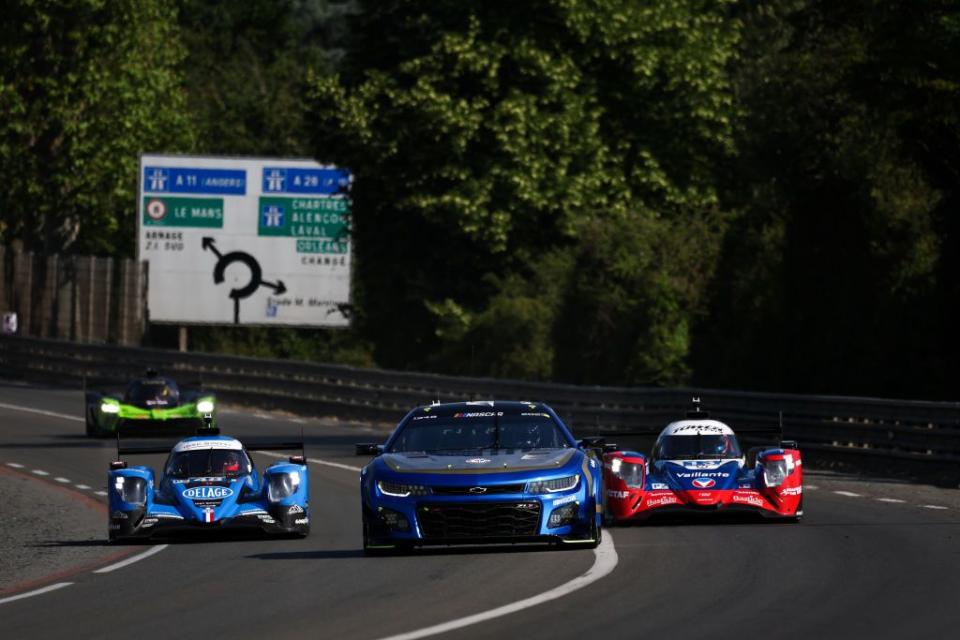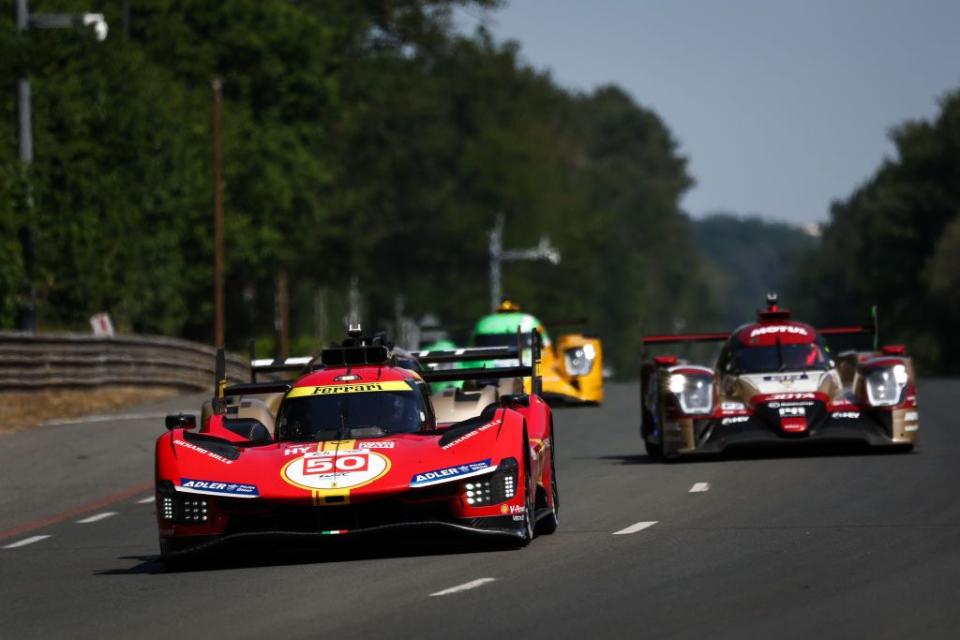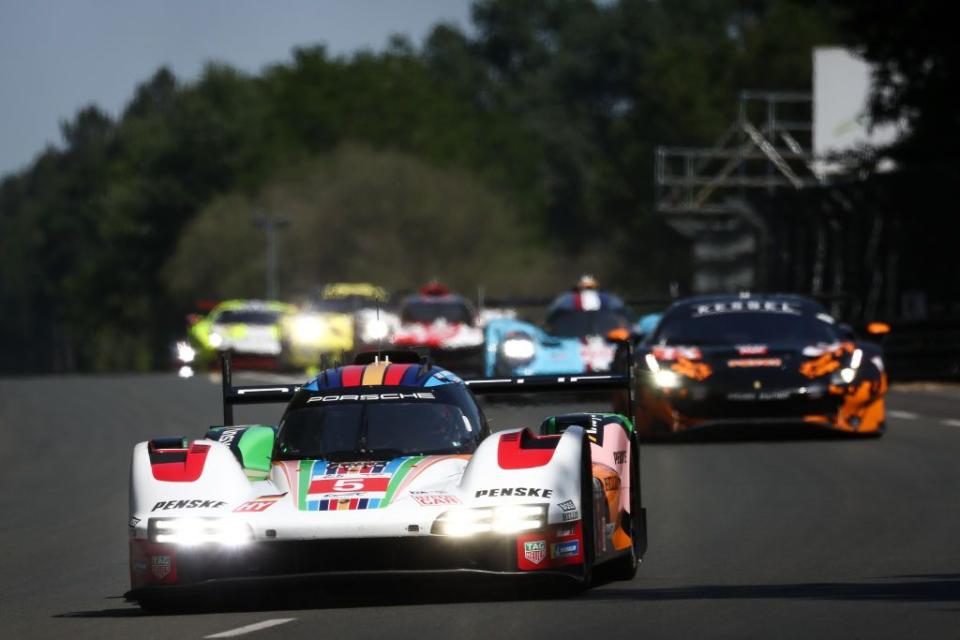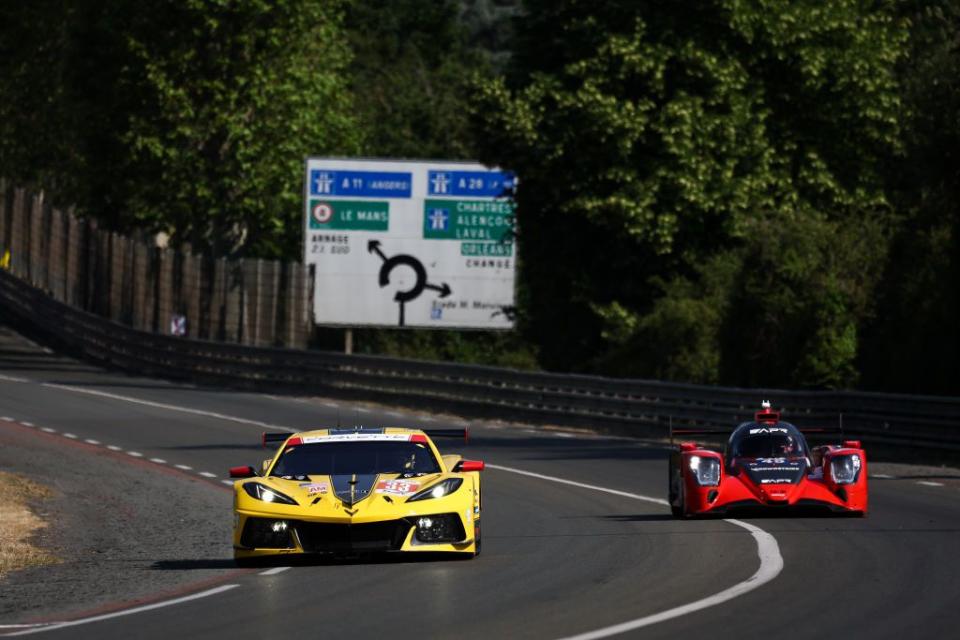24 Hours of Le Mans Test Day More than Song and a Dance to American Hopefuls

Predicting any car other than Toyota’s GR010 Hybrid to win a sixth Le Mans would also constitute poor judgement.
After three opening round victories in the World Endurance Championship, it’s the Japanese manufacturer’s race to lose.
Compared to the GT cars, the NASCAR Camaro is not slow—it was fourth among them in the leisurely first session.
The official Test Day at Le Mans is a song and dance. But on this Sunday, it sold a lot of tickets, judging by the many crowded grandstands between the Main Tribune and Tertre Rouge and the heavy foot traffic in the track’s Village.
An if the Ferrari 499P, Peugeot 9X8 and the Team JOTA customer Porsche 963 are leading the speed charts, it’s a sure indication that lap times are far more waltz than quick-step.
Alas, the song of engines, which can be heard for miles around the Circuit of the Sarthe on a clear day, are reason enough to watch the parade of polite passing on the straights, a preliminary to the 100th year of the race. So much for the strategy of the Hendrick Motorsports Camaro drivers working out of Garage 56, one of the many facets of this complicated and very French presentation known as the Centenary.
The Hendrick drivers were hoping to learn more about high-speed traffic. “How our car is getting into corners and into the braking zone compared to the prototypes is what we’re focused on,” said seven-time NASCAR Cup champion Jimmie Johnson, who will co-drive with Mike Rockenfeller and Jenson Button. “Just trying to learn how we can coexist and where we need to leave a lane and where we can anticipate passing. This is what Jenson, Rocky and myself are worried about now.”

Too bad the ground-pounding thunder of the NASCAR Camaro does not create sound waves strong enough to give it a supernatural buffer against contact from those wheeling faster prototypes. Compared to the GT cars, the NASCAR Camaro is not slow—it was fourth among them in the leisurely first session.
But Rockenfeller can attest to staying in one’s lane, albeit from the reverse angle. At the flat-out kink between Mulsanne and Indianapolis at Le Mans in 2011, his Audi R18 glanced off the Ferrari Italia of Rob Kauffman, then turned left into the barriers. The Audi went straight through the steel fence and by time safety personnel arrived, Rockenfeller had disappeared in the dense night, crawling out dazed and disoriented after the massive crash but okay. Nobody was ever more thankful for a strong chassis and the HANS Device. Meanwhile, gentleman driver Kauffman was asked to stand down by race officials in favor of Michael Waltrip continuing, which makes about as much sense as anything else at the Circuit de La Sarthe. It was Rockenfeller, as the saying goes, who chose poorly.
The bottom line for the Hendrick Motorsports entry is finishing the race to become only the second Garage 56 entry to finish the race since the experimental category was created in 2012.
Predicting any car other than Toyota’s GR010 Hybrid to win a sixth Le Mans would also constitute poor judgement. After three opening round victories in the World Endurance Championship, it’s the Japanese manufacturer’s race to lose. But hope, older than even the cobblestones in the Plantagenet city in the center of Le Mans, springs eternal.
“We arrive at Le Mans expecting to do our best,” said James Calado, a two-time winner in the Ferrari 488 GTE who will be driving one of the new and splendiferous 499P prototypes. “We know we have a good car with a package that suits the fastest sectors of the Le Mans track. In performance terms, I think we will have the chance to do well in a race in which, of course, we will test the reliability of the 499P to the utmost. The prime goal is making it to the checkered flag while getting on the podium or scoring a victory would be even more of a dream come true.”

In other words, strive to be third and in line for the top step if the Toyota team’s race turns out to be something other than a bonne journée. That’s also the kind of thinking at work in the factory camps of Porsche and Cadillac in addition to Ferrari.
The Test Day and its waltz are reminiscent of a W.C. Fields line. “Hair’s a wig. As for the teeth, I couldn’t say.” By going too fast, teams risk an arbitrary BOP adjustment from the organizers, whose decision-making authority is sacrosanct. You’d have to be nuts to risk their ire, although some might say the nuts, in fact, are in the tower.
I once had a baseball coach who had a deep understanding of the game. He bought high-priced, pinstriped flannel uniforms for our high school team, because looking the part can be half the battle. On this day, all 56 entries presented colorful paint schemes. Sure, some are over the top. But all the major factory-backed prototypes have well thought out colors and schemes, as one might expect at a race where annual budgets for the new hybrids begin at $50 million.

There may be only be one winner, but factories are already winning style points in the much-ballyhooed Hypercar class’s two divisions of LMH and LMDh, the latter being the version known as GTP that hails from U.S. soil in this new age of convergence. These hybrid cars are surely the excitement behind a bumper crop of fans on this Test Day, when the new machines joined the circuit, to use the vernacular, for the first time. (The grandfathered GTE class entries are having their last race. The ORECA 07-dominated LMP2 cars, meanwhile, might outlast the cobblestones in the old city.)
If one considers constantly winning Le Mans stylish, then Toyota’s predominantly white GR010 looks best, despite its 1950s pick-up truck rear fenders. Among the new manufacturers on the scene, Ferrari is first when it comes to appearance. Sleek as an arrow, beautifully marked in factory yellow and screaming red, the 499P is at once graceful and powerful looking. And fast. It was third at Spa in Round 3 with what appears to be a delicate balance between downforce and drag thanks to its clever rear wing.
Just turning a blind eye for the moment, the Cadillacs, known locally as the cad-ee-acks, sound effing terrific. They look good, too, and possibly most resemble their namesake street cars, if one squints a bit. Above all, if you listen to the yellow, blue or red Caddies come through the Esses, you can hear their sonorous roar all the way from Tertre Rouge in the near distance and then to the first stretch of the Mulsanne. They are equipped, of course, with full blown atmospheric racing engines, unlike the good ol’ NASCAR V8 in the Camaro, which tends of have more ground-pounding thunder than a higher-pitched racing roar.

Porsche’s factory team run by Team Penske present the cleverest paint scheme, mixing all those winners from years past into one scheme on the 963. Bravo. It’s not easy to portray a pink pig alongside a Rothman’s cigarette deal, among other confabulations. The Porsche 963s, so aptly named given the success of the 962, still stand out among the predominantly single-colored cars of Toyota, Ferrari and Cadillac.
Standing out in baby blue, the hot rod award goes to the Glickenhaus with its extended flat front cowling. Designed in Italy and third on the podium last year, the matching brace of Glickenhaus 007s are a rakish and sentimental sight, given the effort last year by the American team and sheer chutzpah of namesake boss Jim Glickenhaus. His relatively small specialty track day car company took on Le Mans and has the hardware to show for it.

Whither Peugeot? Well, once again the French designers have handed their racing team a project, this time an innovative piece with no rear wing. The last time this amount of innovation happened with the 908 HDi FAP, it took years to reach the top step of the podium at Le Mans, a race that matters most to the car-crazed French, if only because it’s so close to Paris.
Absent a rear wing and fantastic looking in photos, one imagines the 9X8 would stand out sur la piste. Oh, well. Peugeot always seems to find a way to win, going back to the 903. So far, it has yet to finish a 24-hour test without a technical failure
If you’re looking for an American winner, the Corvette C8.R is the odds-on favorite, because Texan Ben Keating is the best gentlemen in the GTE class that now requires a bronze-listed driver. With better luck, the C8.R could have won last year, the first time it appeared in the more universal GT3 configuration.

Given the amount of toil and sweat, everybody deserves to win at Le Mans—or at least finish.
I was here when the Silk Cut Jaguar XJR9 of Tom Walkinshaw Racing finally dethroned Porsche’s 956/962 in 1988. I happened to be in the nearly empty Porsche pit for the sake of safety at the finish. The front straight had been overwhelmed by the British hordes who had stormed across the fences and surrounded the winning Jaguar. Little Jan Lammers, standing on his car’s fenders, double-cranked the victory celebration by taking off his gloves and throwing them into the sea of adoring Brits, up all night cheering and drinking beer.
A Porsche mechanic in overalls, meanwhile, came through the German team’s pit and handed a half-empty bottle of champagne to Herr Falk, one of the racing team principals at Weissach. The mechanic then trudged back out and into the gravel that was the crunchy path underneath the old pit stands. In an otherwise empty stall surrounded by the history of unceremonious cement block, Herr Falk turned the bottle up and drank the bitter juice ... then reached for a handkerchief in his back pocket and gently daubed his eyes.

 Yahoo Autos
Yahoo Autos 